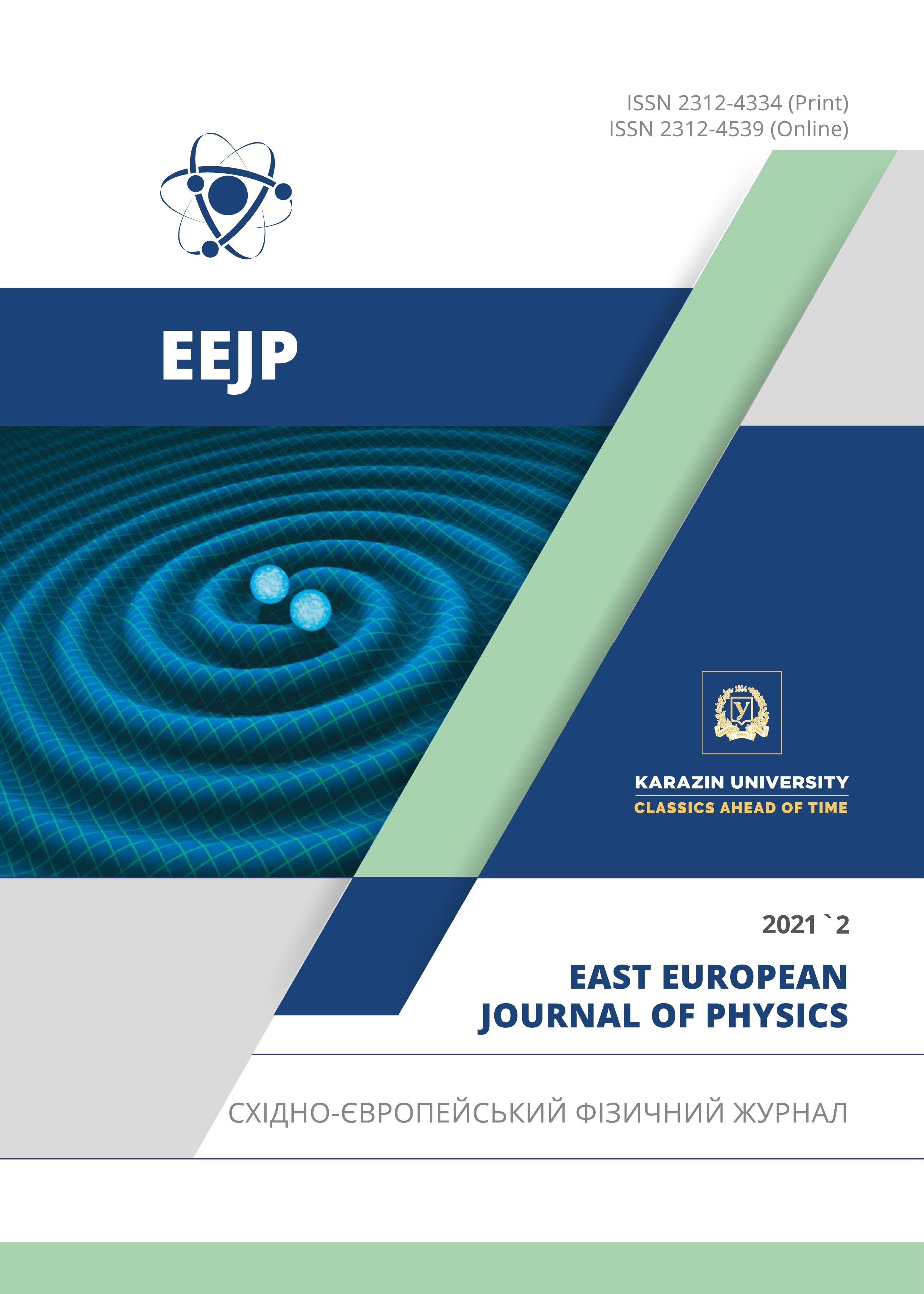Моделювання та імітація безсвинцевого перовскітного сонячного елемента з використанням програми SCAPS-1D
Анотація
У цій роботі було вивчено вплив деяких параметрів на перовскітний сонячний елемент (PSC) на основі олова (CH3NH3SnI3) шляхом моделювання пристрою щодо регулювання концентрації легування перовскітного поглинаючого шару, його товщини та спорідненості транспортного середовища електронів та дірково-транспортувального середовища до електрону, а також щільності дефектів перовскітного поглинаючого шару та рухливості дірок в дірково-транспортувальному матеріалі (HTM). Моделюючий пристрій: програма одномірного імітатора ємності сонячних елементів (SCAPS-1D) була використана для моделювання перовскітних сонячних елементів на основі олова. Крива вольтамперноі характеристики (J-V), отримана шляхом моделювання пристрою без оптимізації, показує вихідні параметри елемента, які включають: напругу розімкнутого контуру (Voc) = 0,64 В, щільність струму короткого замикання (Isc) = 28,50 мА/см2, коефіцієнт заповнення (FF) = 61,10% та ефективність перетворення потужності (PCE) = 11,30% при імітованому AM1,5, сонячному світлі, = 100 мВт/см2 при 300K. Після оптимізації було визначено, що значення концентрації легування, щільності дефектів, спорідненості до електронів матеріалу для транспортування електронів та дірково-транспортувального матеріалу становлять: 1.0x1016cm-3, 1.0x1015cm-3, 3.7 еВ та 2,3 еВ відповідно. Порівняно з початковим пристроєм без оптимізації, були отримані помітні значення параметрів сонячних елементів при Jsc = 31,38 мА/см2, Voc = 0,84 В, FF = 76,94% та PCE = 20,35%, що демонструє поліпшення в ~ 1,10 рази для Jsc ~ 1,80 рази для PCE ~ 1,31 рази для Voc, та ~ 1,26 рази для FF. Результати показують, що безсвинцевий перовскітний сонячний елемент CH3NH3SnI3 , який є екологічно чистим, є потенційним сонячним елементом з високою теоретичною ефективністю 20,35%. CuI показав, що він також може бути потенційним дірково-транспортувальним шаром.
Завантаження
Посилання
Z. Wang, Q. Lin, F.P. Chmiel, N. Sakai, L.M. Herz, and H.J. Snaith, Nature Energy, 2, 17135 (2017), https://doi.org/10.1038/nenergy.2017.135.
Y. Liu, Z. Yang, D. Cui, X. Ren, J. Sun, X. Liu, J. Zhang, Q. Wei, H. Fan, F. Yu, X. Zhang, C. Zhao, and S. Liu, Advanced Materials, 27, 5176–5183 (2015), https://doi.org/10.1002/adma.201502597.
D. Yang, Z. Yang, W. Qin, Y. Zhang, S. Liu, and C. Li, Journal of Materials Chemistry A, 3, 9401–9405 (2015), https://doi.org/10.1039/C5TA01824B.
A. Kojima, K. Teshima, Y. Shirai, and T. Miyasaka, Journal of the American Chemical society, 131(17), 6050-6051 (2009), https://doi.org/10.1021/ja809598r.
D. Eli, M.Y. Onimisi, S. Garba, R.U. Ugbe, J.A. Owolabi, O.O. Ige, G.J. Ibeh, and A.O. Muhammed, J. Nig. Soc. Phys. Sci. 1, 72–81 (2019), https://doi.org/10.46481/jnsps.2019.13.
NREL Efficiency chart, (2019), https://www.nrel.gov/pv/assets/images/efficiencychart- 20180716.jpg.
D. Hui-Jing, W. Wei-Chao, and Z. Jian-Zhuo, Chinese Phys. B, 25, 108802 (2016), https://doi.org/10.1088/1674-1056/25/10/108802.
A. Farhana, M. Rafee, S.S. Sakin, and M.U. Saeed, International Journal of Photoenergy, 9846310 (2017), https://doi.org/10.1155/2017/9846310.
Syed Zulqarnain Haider, Hafeez Anwar, and Mingqing Wang, Semicond. Sci. Technol. 33(3), 035001 (2018), https://orcid.org/0000-0002-0473-850X.
F. Hao, C.C. Stoumpos, R.P.H. Chang, and M.G. Kanatzidis, J. Am. Chem. Soc. 136(22), 8094-8099 (2014), https://doi.org/10.1021/ja5033259.
F. Hao, C.C. Stoumpos, P. Guo, N. Zhou, T.J. Marks, R.P.H. Chang, and M.G. Kanatzidis, J. Am. Chem. Soc. 137, 11445 (2015), https://doi.org/10.1021/jacs.5b06658.
K.G. Lim, S. Ahn, Y.H. Kim, Y. Qi, and T.W. Lee, Energy Environ. Sci. 9, 932–939 (2016), https://doi.org/10.1039/C5EE03560K.
H. Kim, K.G. Lim, and T.W. Lee, Energy Environ. Sci. 9, 12–30 (2016), https://doi.org/10.1039/C5EE02194D.
F. Hao, K. Stoumpos, D. H. Cao, R. P. H. Chang, and M. Kanatzidis, Nature Photonics, 8(6), 489-494 (2014) https://doi.org/10.1038/nphoton.2014.82.
D.B. Mitzi, C.A. Field, Z. Schlesinger, and R.B. Laibowitz, J. Solid State Chem. 114, 159–163 (1995), https://doi.org/10.1006/jssc.1995.1023.
D.Y. Liu, M.K. Gangishetty, and T.L. Kelly, J. Mater. Chem. A, 2, 19873-19881 (2014), https://doi.org/10.1039/C4TA02637C.
N.K. Noel, D.S. Samuel, A. Antonio, W. Christian, G. Simone, H. Amir-Abbas, S. Aditya, E.E. Giles, K.P. Sandeep, B.J. Michael, P. Annamaria, M.H. Laura, and J.S. Henry, Energy Environ. Sci. 7, 3061-3068 (2014), https://doi.org/10.1039/c4ee01076k.
X. Li, J. Yang, Q. Jiang, W. Chu, D. Zhang, Z Zhou, and J. Xin, ACS Appl. Mater. Interfaces, 7b, 14926 (2017), https://doi.org/10.1021/acsami.7b14926.
G.A. Sepalage, S. Meyer, A. Pascoe, A.D. Scully, F. Huang, U. Bach, Y.B Cheng, and L. Spiccia, Adv. Funct. Mater. 25, 5650 5661 (2015), https://doi.org/10.1002/adfm.201502541.
Автори, які публікуються у цьому журналі, погоджуються з наступними умовами:
- Автори залишають за собою право на авторство своєї роботи та передають журналу право першої публікації цієї роботи на умовах ліцензії Creative Commons Attribution License, котра дозволяє іншим особам вільно розповсюджувати опубліковану роботу з обов'язковим посиланням на авторів оригінальної роботи та першу публікацію роботи у цьому журналі.
- Автори мають право укладати самостійні додаткові угоди щодо неексклюзивного розповсюдження роботи у тому вигляді, в якому вона була опублікована цим журналом (наприклад, розміщувати роботу в електронному сховищі установи або публікувати у складі монографії), за умови збереження посилання на першу публікацію роботи у цьому журналі.
- Політика журналу дозволяє і заохочує розміщення авторами в мережі Інтернет (наприклад, у сховищах установ або на особистих веб-сайтах) рукопису роботи, як до подання цього рукопису до редакції, так і під час його редакційного опрацювання, оскільки це сприяє виникненню продуктивної наукової дискусії та позитивно позначається на оперативності та динаміці цитування опублікованої роботи (див. The Effect of Open Access).








